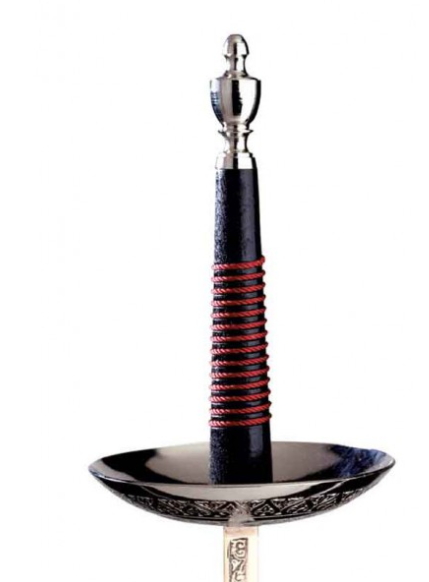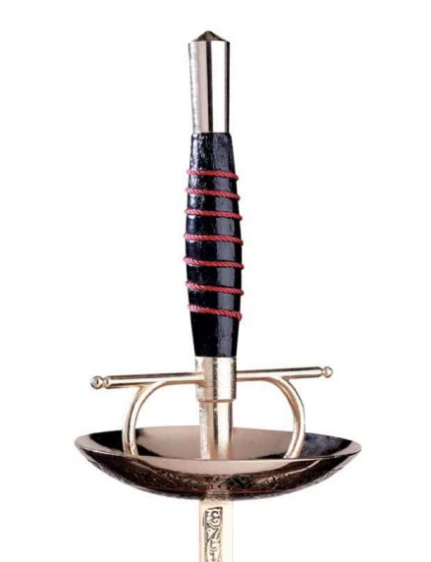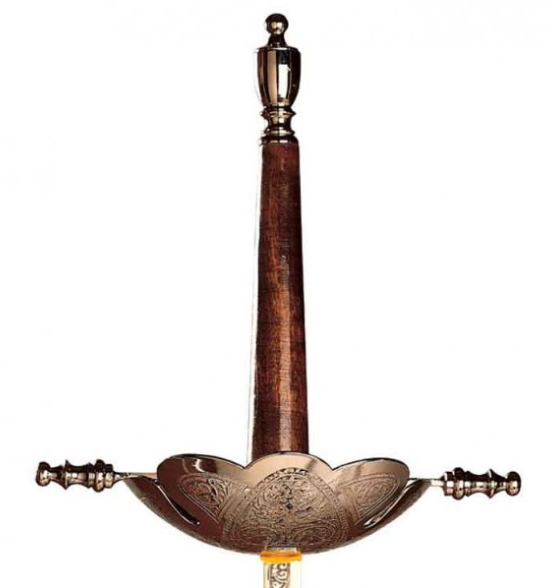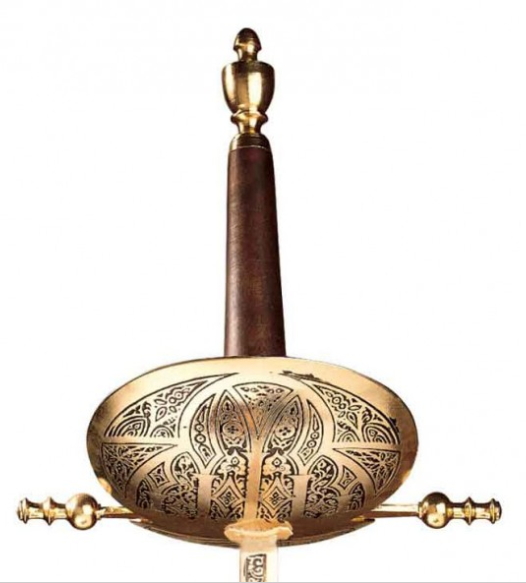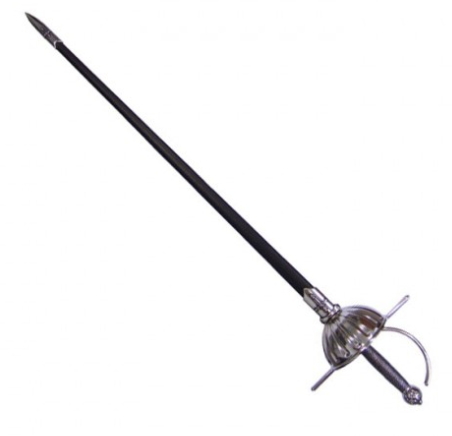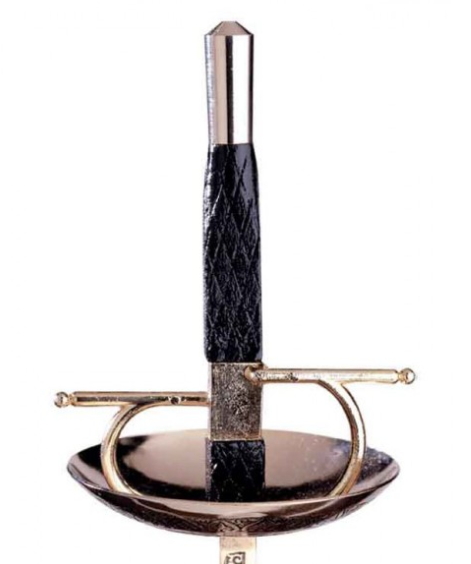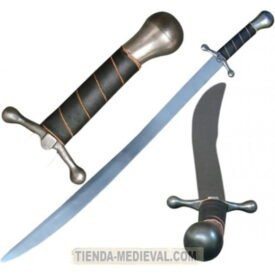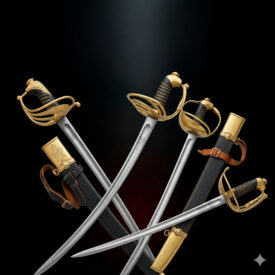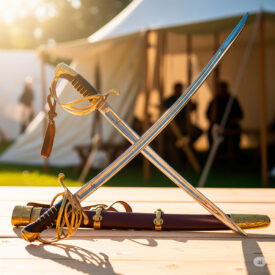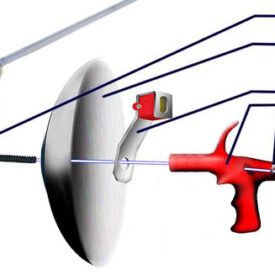The world of fencing is as fascinating as it is complex, a martial art that has become a sport of precision and strategy. Within this universe, the foil holds a special place, being one of the three main disciplines alongside the épée and the saber. But the foil is much more than a simple sporting weapon; its history and design have also elevated it to the category of a piece of art. Join us to discover the different types of foils and their surprising evolution!
The foil is one of the three weapons in fencing, along with the épée and the saber, all made of tempered steel. However, in the sport of fencing, foilists are considered the most skilled, as this weapon is the most technical of the three and requires greater mental and physical dexterity. Its movements, such as parries and ripostes, demand superior skill and speed, turning each assault into a true strategic dance.
1. The Foil in the Sport of Fencing: Precision and Strategy
The foil is known as the «queen of weapons» due to its inherent elegance and sophistication. It is an iconic weapon in fencing, a combat sport that has been part of the Olympic program since the first Modern Games in Athens 1896, notable for its focus on technique and mental agility.
1.1 Origin and Historical Role: From Practice to Olympic Sport
Unlike the épée and saber, the foil is the only one of the three fencing weapons that did not originate directly from a wartime environment. Its origin dates back to the 16th and 17th centuries in Europe, popularizing as a weapon specifically designed for the practice and training of fencing. It emerged as a reaction to the prohibition of duels, allowing fencing to continue to be practiced with a lighter weapon and without a sharp point. In fact, initially, the tip was shaped like a flower, hence its name, a detail that underlines its non-lethal purpose and its focus on learning. Furthermore, it did not require full facial protection, which facilitated its use in training environments.
Throughout the 17th century, the foil was conceived as an essential training weapon for nobles, who used it to perfect their skills without the risk of serious injuries. Over time, this practice tool evolved to become the preferred sword for fencing competition, laying the foundations for what we now know as modern fencing. Its development was crucial for the formalization of the rules and techniques that define this sport.
1.2 Technical Characteristics and Rules of Sport Foil
The foil is a light and agile weapon, ideal for sport fencing. It is characterized by a narrow and flexible blade, typically about 90 cm in length, and a maximum total size of 110 cm from tip to pommel. Its weight is approximately 0.5 kg (500 grams), making it a very manageable weapon. The blade has a trapezoidal shape, which gives it adequate resistance for sports practice.
In foil fencing, valid touches are made only with the tip of the weapon, which must impact perpendicularly to register. Furthermore, the valid target area is strictly limited to the opponent’s torso, which includes the chest and the area covered by the metallic jacket. Any touch on the limbs, head, or outside the valid area does not count as a point. The tip of the sport foil incorporates an electronic device that registers touches, lighting up a colored light on the signaling apparatus to indicate a valid impact, which ensures objectivity in refereeing.
The foil is a long, flexible sword with a rectangular cross-section blade. It has four edges and usually does not have a ring on the hilt, which visually distinguishes it from other weapons such as the rapier. The minimum allowed blade length for foil and épée is 90 cm, and for saber, it is 88 cm, with a maximum weapon length of 110 cm for the first two and 105 cm for the saber. The maximum authorized weight must be less than 500 g for the foil and saber and 750 g for the épée. These specifications ensure standardization and fairness in competition.
1.3 The «Convention»: A Dance of Priorities and Strategy
A distinctive characteristic of the foil (shared with the saber) is the application of the «convention» or priority rules. This means that, if both fencers touch at the same time, the point is awarded to whoever had the initiative in the attack. This initiative can be lost if the attack action fails, is diverted, or if the opponent can «steal it» by correctly parrying the attack and counter-attacking immediately. The convention introduces an element of interpretation by the referee, who must analyze what has happened in an action to determine changes in priority. This requires great technical finesse and a deep knowledge of fencing rules on the part of fencers and judges. The convention adds a layer of strategic complexity, forcing fencers to not only execute their movements with precision but also to understand and anticipate their opponent’s intentions.
1.4 The Foil as an Educational Tool and for Personal Development
The foil is considered the learning weapon par excellence in fencing. Many fencing schools use it as a fundamental tool in the teaching process, developing precision, attack dexterity, coordination, and mental discipline. For example, in the French blason system, fencers’ skills are measured through the foil throughout the formative stage, from 6 to 12 years of age. This approach allows young people to develop a solid foundation in fencing before specializing in other weapons.
Foil practice not only improves physical skills, such as reflexes and speed, but also fosters the development of strategic intelligence and self-control. Young people leverage their innate reflexes and speed, while adults find in the foil a way to enhance their tactical intelligence and their ability to stay calm under pressure. This combination of physical and mental demands makes foil fencing highly recommended for people of all ages, offering benefits that transcend the sporting realm.
2. The Foil in Decoration: Beauty and Collection
Beyond its functionality on the fencing strip, the foil has transcended its original purpose to become a highly valued decorative piece. Its intrinsic beauty, delicacy, and stylized design make it ideal for adorning elegant and sophisticated spaces, adding a touch of distinction and style. It is a symbol of elegance and skill worthy of admiration in homes, offices, and private collections.
2.1 From the Strip to the Elegant Space: A Symbol of History and Style
The foil is appreciated by collectors and history lovers not only for its connection to sport and nobility, but also for its aesthetics. It stands out for its elegance and the detail in its manufacturing, even in decorative versions. It is an excellent option for both the collection of historical weapons and for display in a modern setting, creating a focal point of conversation and admiration.
2.2 Decorative Types and Designs: A Variety for Every Taste
Within the universe of decorative foils, we can find diverse categories and styles that reflect both the historical evolution of the weapon and contemporary aesthetic preferences:
- Exhibition Foils: These are highly detailed replicas of historical foils, manufactured with high-quality materials and refined finishes. These foils are designed to be the center of attention in collections or as decorative elements in living rooms, libraries, or studies. They often faithfully reproduce the designs of past eras, with elaborate hilts and ornamented bells.
- Mini Foils: These are miniature versions of traditional foils, designed as ornaments, paperweights, or even letter openers. They are ideal for display in display cases, desks, or shelves, offering a touch of sophistication in smaller spaces.
- Traditional/Historical Designs: Decorative foils can feature styles based on specific historical or regional designs. Some of the most recognized types include:
- Castañeta Foil: Characterized by a guard reminiscent of castanets, offering a unique and traditional design.
- French Foil: With a straight grip and a simple guard, it is a classic and elegant design.
- Spanish Foil: Often features a more elaborate guard, such as the shell or loop guard, reflecting the rich Spanish armory tradition.
- Shell Foil: This type is distinguished by its shell-shaped bell, which offers additional hand protection and a particular aesthetic appeal.
- Rose Foil: Named for the flower shape on its button, a nod to the foil’s origins as a training weapon.
These foils can have engraved or plain blades, and finishes in gold, nickel, or rustic, allowing for a wide variety of options for the collector. They are usually available in cadet (around 80 cm) and natural (around 102-104 cm) sizes, adapting to different display spaces.
2.3 Materials and Choice for Collection: Quality and Authenticity
To ensure the durability and corrosion resistance of a decorative foil, it is recommended to opt for those made with quality materials such as stainless steel or bronze, which offer excellent resistance to the passage of time and oxidation. Other common materials in the manufacture of decorative foils include zinc alloy, which allows for intricate designs at a more accessible cost. When choosing a foil as a decorative element, it is crucial to consider the quality of the materials, the design, the authenticity of the model (if it is a historical replica), the durability, and whether it includes ornamental details that match your aesthetic preferences. A well-chosen foil can become a centerpiece in any decor, reflecting a taste for history and elegance.
2.4 Decorative vs. Functional Foil: Knowing the Key Differences
It is essential to distinguish between a decorative foil and a functional one, as their purposes and manufacturing characteristics are very different. A decorative foil is designed primarily for display and ornamentation, prioritizing visual appearance and aesthetic details. Generally, it is manufactured with materials that, although attractive, may not have the same strength or flexibility as those used in a functional weapon, and its construction is not intended to withstand the rigor of fencing practice.
On the other hand, a functional foil is made with high-quality materials, such as lighter and more resistant alloys (stainless steel or titanium for the blade), and is suitable for actual fencing practice. Its design is simpler and more efficient, focusing on performance, balance, and the fencer’s safety. Professional foils also tend to have better precision, optimized balance, and greater flexibility in the blade, essential characteristics for competition and intensive training. The parts of the functional foil are the blade, the guard, the socket, the pommel, the nut, and the counterweight, each designed to contribute to the weapon’s optimal performance.
3. The Foil in the Context of Olympic Fencing: A Trio of Styles
Olympic fencing offers three unique disciplines: foil, épée, and saber, each with its own history, technique, and regulations. All three weapons have been part of the Olympic Games program since Athens 1896, with the épée debuting in Paris 1900. Understanding the differences between them is key to appreciating the richness and diversity of this ancient sport.
3.1 Foil vs. Épée: The Precision of the Point vs. the Freedom of the Duel
Although both are point weapons, the épée is considered the quintessential dueling weapon and is heavier than the foil. The main difference lies in the rules: the épée has no «priority» or «convention» rules. If both fencers hit at the same time, both score, which is known as a «double touch.» Furthermore, with the épée, you can touch any part of the opponent’s body, from head to toe, which allows for greater strategic freedom and a more direct approach to attack. This can make épée combat more complex and tactical, as there is no need to interpret the attack’s initiative. The épée blade is the most rigid of the three weapons, weighing 0.77 kg (750 grams), which gives it greater impact force. Opponents in fencing are called fencers. When a fencer is touched by the opponent’s weapon, they receive a point, provided the touch is valid according to the rules of each weapon.
3.2 Foil vs. Saber: The Elegance of the Point vs. the Explosiveness of the Edge
The saber is the most different and dynamic of the three weapons, directly linked to its military use as a cavalry weapon. Saberists are considered a «breed apart» within fencing due to their unique combat style. Like the foil, the saber uses the convention or priority rules, meaning that the attack’s initiative is crucial for scoring. However, unlike the foil, with the saber you can touch the opponent with both the tip and the edge of the blade, which opens up a much wider range of offensive actions. The valid target area is also wider, covering from the waist to the head, including hands and arms, which requires very fast and coordinated defense and attack. The saber is the shortest of the three weapons (105 cm total length with an 88 cm blade and a slight curve), but combat with it is the fastest and most offensive, requiring great explosiveness, reflexes, and constant mental agility. Visually, a clear difference is seen in the guard: the sabrist holds the saber with the tip pointing upwards, while with the épée and foil the tip points towards the opponent, a detail that reflects the different combat philosophies of each weapon.
4. Purchase and Usage Recommendations: The Ideal Foil for Every Fencer
Choosing the right foil is crucial, whether for sports practice or to enrich a collection. The choice will depend on your experience level, your goals, and your personal preferences. Below, we offer some recommendations:
4.1 For the Beginner: A Solid and Safe Start
If you are taking your first steps into the world of fencing, it is essential to choose a foil that allows you to learn the basics safely and effectively. Beginner foils are usually more robust and less expensive, designed to withstand intensive use in classes. Look for models with tempered steel blades that offer good flexibility without being excessively soft. The grip should be comfortable and provide a firm hold. Many fencing clubs offer rental equipment or sell basic foils, which is an excellent option to start without a large initial investment. Prioritize safety and durability over advanced features, as your main goal will be to master fundamental technique.
4.2 For the Intermediate and Advanced Fencer: Performance and Customization
As your skill progresses, you may seek a foil that offers better performance and adapts more to your combat style. Intermediate and advanced fencers often prefer foils with higher quality blades, often made of maraging steel, which offer superior durability and response. The choice of grip (French, Italian, anatomical) becomes more personal, as it directly affects the control and feel of the weapon. Consider the balance of the foil; a good balance can improve your agility and precision. Many experienced fencers choose to customize their foils, selecting individual components (blade, guard, grip, pommel) to create a weapon that perfectly fits their needs and tactical preferences. The investment in a higher quality foil is justified by improved performance and durability.
4.3 For the Occasional Adventurer and Collector: Aesthetics and Authenticity
If your interest in the foil is more recreational, historical, or decorative, the choice will focus on aesthetics, authenticity, and the quality of finishes. For those looking for a piece to display, decorative foils are the ideal option. You can opt for historical replicas that capture the essence of different eras, such as Spanish, French, or Italian foils with their distinctive guards. Pay attention to the materials of the bell guard and grip, which can be engraved metal, noble wood, or even ivory in luxury replicas. If you are looking for a foil for historical reenactment events or controlled exhibitions, make sure it is a safe replica and complies with authenticity standards. For the collector, rarity, provenance, and conservation status are key factors. A suitable foil stand, such as the one shown in the image, is essential for displaying and protecting your collection.
5. Maintenance and Care of the Foil: Prolonging its Useful Life
Proper maintenance is essential to prolong the useful life of your foil, whether it is for sport or decoration. For functional foils, it is crucial to clean the blade after each use to remove sweat and dirt, which can cause corrosion. Use a soft, dry cloth, and consider applying a thin layer of protective oil if the foil will be stored for a while. Periodically check the tip and wiring (in electric foils) to ensure they are working correctly and that there is no damage. The guard and grip should also be cleaned regularly. Store the foil in a dry and safe place, preferably in a case or bag that protects it from bumps and humidity.
For decorative foils, maintenance is simpler but equally important. Regularly wipe off dust with a soft cloth. If the piece has metallic details, you can use a specific metal cleaner to maintain its shine, always following the manufacturer’s instructions. Avoid direct exposure to intense sunlight or sudden changes in temperature and humidity, as these can affect the materials and finishes. Good care ensures that your foil, whether it is a combat tool or a work of art, retains its beauty and functionality over time.
On Guard: The Legacy of the Foil
The foil is, without a doubt, a central piece in the world of fencing and an object of admiration in its own right. Its light design, its focus on precision and technique, and its fascinating history make it an outstanding choice, whether for those looking to perfect their skills on the strip or for those who wish to add a piece of great elegance and sophistication to their collection. From its origins as a training weapon to its current status as an Olympic discipline, the foil has proven to be an enduring symbol of dexterity, discipline, and art. Exploring its various types and understanding its characteristics is to immerse oneself in a rich and vibrant tradition that continues to captivate enthusiasts around the world. If you are looking to acquire a foil, whether for practice or for your collection, we invite you to explore the available options.
You can find a wide variety of high-quality foils, as well as sabers and rapiers, by visiting the foil selection, the sabers, and the loop-hilted rapiers and cup-hilted rapiers. Find the perfect weapon that suits your passion for fencing and history!

